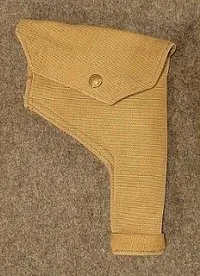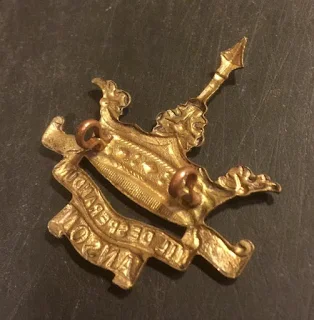In a very recent question, Ken a reader of this blog asked the following multiple part question; “Apart from officers, who were usually issued with pistols? Bren gunners? Which units carried the flamethrowers? What's the best place for finding photos of the uniform worn at Arnhem?”
Given the nature of the question, and the convoluted protocol currently required by the Google Blog to adequately respond to a comment, I have decided it would be far more efficient just to publish an article on the subject. One further caveat, this author’s discussion will be confined to WWII British Airborne Forces during Operation Market-Garden. However, prevailing logic would lead one to conclude it to be generally applicable to the balance of the British Army.
First, right up front my answer is at best provisional. As far as I can determine from my research to date, there was no strict set of regulations issued by the British Army in WWII governing the issuance of “pistols” (more correctly revolvers or semi-automatic pistols). The known exception covering the Inglis Browning Pistol No.2 Mk I* , to the Airborne Forces (https://arnhemjim.blogspot.com/2015/12/were-inglis-or-patchett-machine-carbine.html.) . The same was the case in World War I. An Internet search reveals at least one M.A. Degree dissertation on the subject; http://www.worldwar1.com/tripwire/pdf/davidthomas.pdf Unfortunately a comparable document on the subject in World War II has not yet been discovered. Obviously, hence Ken’s question, as I’m certain he has already conducted a similar search.
One of if not the best source of empirical evidence, is contemporary photographs. Fortunately, there was a team from the Army Film and Photographic Unit (AFPU) attached to the 1st Airborne Division during the entire operation. As far as known to this author the best compilation of their work is found in the two volumes, After the Battle OPERATION MARKET GARDEN THEN AND NOW, Karel Margry, Editor, Battle of Britain International Ltd, London, 2000. It is also the best single source of knowledge for what was actually wore by personnel during the operation, also the answer to one of Ken’s questions.
Based upon contemporary TO&Es, the above referenced set of images, and common sense, there is a very high probability that the following personnel carried either a revolver or semi-automatic pistol;
All commissioned officers and warrant officers (most frequently also carried a rifle or machine carbine).
All non-commissioned officers (with the rank of sergeant and above).
All dispatch riders.
All non-commissioned officers (with the rank of sergeant and above).
All dispatch riders.
Most glider pilots.
Most personnel driving universal carriers (predominately Royal Army Service Corps and REME).
Although not present at Operation Market-Garden; Most tank and armoured vehicle (AFV) commanders, drivers, and crewmen (Royal Tank Regiment and Royal Ordnance Corps)
Most Tractor, Artillery, Morris C.8/AT Mk III drivers (prime mover for 17pdr AT Guns
Most Military Policemen.
Some radio operators
Some flamethrower operators (predominately trained Royal Engineers).
Some No. 1 Mortarmen.
All No. 1 Bren Gunners (specifically prescribed for Airborne Forces).
Some P.I.A.T. gunners.
Some Medical Orderlies.
Although not present at Operation Market-Garden; Most tank and armoured vehicle (AFV) commanders, drivers, and crewmen (Royal Tank Regiment and Royal Ordnance Corps)
Most Tractor, Artillery, Morris C.8/AT Mk III drivers (prime mover for 17pdr AT Guns
Most Military Policemen.
Some radio operators
Some flamethrower operators (predominately trained Royal Engineers).
Some No. 1 Mortarmen.
All No. 1 Bren Gunners (specifically prescribed for Airborne Forces).
Some P.I.A.T. gunners.
Some Medical Orderlies.
The quantifiers 'most' and 'some' are used because as previously indicated there are no known specific directives established for issuance. Broad rule of thumb and logical guidance being any individual who required use of both hands to continuously operate their assigned equipment in combat.
Per various references including; War Department Technical Manual HANDBOOK ON THE BRITISH ARMY WITH SUPPLEMENTS ON THE ROYAL AIR FORCE AND CIVIL DEFENSE ORGANIZATIONS TM 30 – 410 Sept 30, 1942 (printed 1943):
Per various references including; War Department Technical Manual HANDBOOK ON THE BRITISH ARMY WITH SUPPLEMENTS ON THE ROYAL AIR FORCE AND CIVIL DEFENSE ORGANIZATIONS TM 30 – 410 Sept 30, 1942 (printed 1943):
Scale of pistol allowance by various size of unit.
Armoured Division 14,964 officers and men - 2,324 pistols.
Infantry Division 18,347 officers and men - 1,011 pistols.
Airborne Division 12,416 officers and men - 2,942 pistols (as of late 1944, all semi-automatic).
Field Regiment, Royal Artillery 672 officers and men - 79 pistols.
Machine Gun Battalion 740 officers and men -174 pistols.
Machine Gun Platoon -10 pistols.
Infantry Brigade 2944 officers and men -154 pistols.
Infantry (Rifle) Battalion 845 officers and men - 34 to 47 pistols (depending on year/source).
Rifle Company 124 officers and men - 5 pistols.
Rifle Platoon 37 officers and men - 1 pistol.
Universal Carrier Platoon 64 officers and men - 2 pistols.
In the specific case of the two British Airborne Divisions (1st and 6th ) circa 1944 the Divisional Standard Table of Basic Allowances cites 2,942 “pistols” per division. Until late 1944 these would have been predominately the Pistol, Colt, .45cal Self-loading M1911A1. Order of Battle Allowance for the 1st Airborne Division at that time was 701 officers. That leaves a balance of 2,241 weapons; a significant quantity. I have tried based upon the Division's Order of Battle and TO&E to allocate the remaining weapons, but at best it would only be an educated guess.
The following is a series of images of the most common revolvers and semi-automatic pistols, and their associated holsters, issued in the British Army during World War II.
Pistol, Colt, .45cal Self-loading M1911A1 (predominately Airborne, Commando, and Special Forces)
(Author's note: In addition there were some M1911s (see second image) and some M1911A1s in .455cal)
(Author's note: In addition there were some M1911s (see second image) and some M1911A1s in .455cal)
Pistol, Inglis Browning, 9mm Self-loading, No.2 MkI* (predominately Airborne, Commando, and Special Forces), only after November 1944
Pistol, Webley .455cal, No.1 MkVI (Revolver)
Pistol, Enfield, .380cal No.2 Mk1 (Revolver)
Pistol, Webley, .38cal MkIV (Revolver, Limited Standard)
Pistol, Enfield, .38cal, No.2 MkI* (Revolver, “Commando/Tanker Model”)
.


































